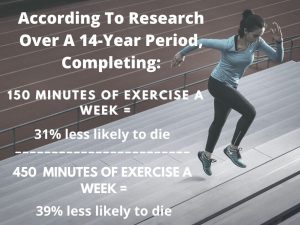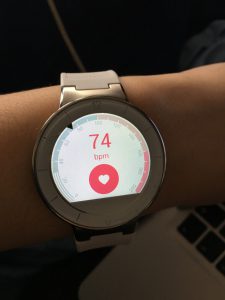Do you wear a fitness tracker? If so, do you love the little celebration it gives you at the end of the day when you’ve hit that magical target of 10,000 steps? And do you feel a little bummed if you don’t get to that goal? It’s understandable – we all want to feel like we’re doing the best we can for our health, and we’ve been told that walking at least 10,000 steps a day is one vital way of doing that. But have you ever stopped to think: why 10,000 steps? Is it really a magic number – and is reaching that target enough to keep you fighting fit?
The History of the Magic Number
So that magic number of 10,000 – it must be rooted in solid, scientific research, right? Well, you might be surprised to know that there is not really a whole lot of scientific evidence to back up any claims that 10,000 steps (or around 5 miles) is any better than any other amount of steps, or that it is superior to moving your body in other ways. In fact, the idea that we need to specifically take 10,000 steps a day is actually a decades-old marketing ploy!

Way back in the 1960s, a Japanese company called Yamasa Clock wanted to capitalize on a fitness craze that took hold after the 1964 Tokyo Olympics, and began marketing a pedometer, which they called “Manpo-kei.” Why that name? Apparently, the Japanese characters for that name both look like a person walking AND just so happen to translate to the phrase “10,000 steps meter.” The pedometer took off, and that number somehow stuck in our collective consciousness as the fitness goal we all need to shoot for.
That’s not to say that there isn’t any evidence that taking 10,000 steps is beneficial to your health. We all know that moving more is always better, and some studies investigating this specific step target have shown it improves heart health, mental health, and even lowers diabetes risk – so maybe that’s why we haven’t forgotten about this random number. And, after all, walking around 5 miles a day should translate to walking for around 2 hours a day for the average person, which sounds like a pretty good amount of exercise.
But do you really need to hit that specific target, or can you tell your FitBit to relax if you don’t hit it – and could that goal actually be giving you a false sense of security when it comes to your fitness level?
Is It Really Necessary to Hit 10,000?
Ok, so first the good news about your step count: the most recent research suggests that you don’t actually have to hit 10,000 steps to reap the health benefits of walking. And that is definitely good news for a lot of us: most recent studies show that people in the U.S. tend to only hit 5,000 steps a day at most, with many of us hovering in the 3,000-6,000 step range. And a famous 2005 study out of Belgium found that only 8% of people who were encouraged to reach 10,000 steps everyday for a year actually hit that target; not only that, but virtually none of the participants were hitting that mark four years after the study.
But there is some promising research into the benefits of any moderate amount of walking. For example, a 2019 study led by Dr. I-Min Lee, a professor of epidemiology at the Harvard T.H. Chan School of Public Health found that, for older women, taking as few as 4,400 steps a day reduced the risk of premature death by about 40%, compared to women who completed only 2,700 or fewer steps a day. 
Interestingly enough, though, while the risks for early death continued to drop among women who walked more than 5,000 steps a day, the benefits seemed to max out at around 7,500 steps. In other words, older women who completed fewer than half of that magical 10,000 steps lived a lot longer than those who walked less, but those who got closer to that number didn’t really see a whole lot more in benefits.
And in another 2020 study of nearly 5,000 adults, the people who walked for about 8,000 steps a day were half as likely to die prematurely from heart disease or any other cause as those who walked only 4,000 steps a day. But those who hit their 10,000 steps, or more? The additional benefits were so statistically slight that it didn’t really make any difference. So, it seems that walking a lot is definitely beneficial, but there is no magic number that you have to feel bound by (sorry, fitness tracker!)
And Is Hitting a Step Count Enough to Keep You Healthy?
Nobody is denying that walking is good for you, so we’re not suggesting you stop! And if having an easy to remember goal each day for moving your body, like taking 10,000 steps, works for you, then go for it! After all, according to Daniel Lieberman, a Harvard paleoanthropologist who has studied the evolution of exercise, “We all have deep fundamental instincts to avoid unnecessary activity, so we need those nudges to help people get started.”
With that being said, focusing solely on your step count can become a little problematic. While the small, everyday things that you do to move your body (like walk to work, park further away, or take the stairs) do add up and make a difference, just getting in a certain number of steps won’t necessarily mean you’re as healthy as you can be, or that you’re going to meet any fitness or weight loss goals. Consider the following:
How much you sit the rest of the day matters –
If you are very sedentary for the rest of your day (especially if you’re not moving much for over 13 hours of it), you probably won’t reap the benefits of even a full hour of exercise a day or a specific number of steps.
What other kind of exercise you get matters

The Department of Health and Humans Services (DHHS), and the World Health Organization (WHO) both agree that you need at least 150 minutes of moderate aerobic activity (such as brisk walking or swimming) or 75 minutes of vigorous activity (such as running or dance cardio class) every week, plus they recommend doing strength-training exercise (such as lifting weights, or doing exercises that use your own bodyweight) twice a week. That’s in addition to moving around in the course of your daily life, meaning you should probably be tacking around 2,000-3,000 steps onto your step count everyday, if you’re set on counting steps.
In addition, if you’re looking to lose weight, or keep weight off, you might need to do more exercise – but with that being said, maintaining a healthy weight is ultimately more about what you put in your mouth than getting in a certain number of steps or workouts.
And remember: there are all sorts of types of exercise that are great for you, but won’t increase your step count, like biking or swimming, so don’t forget to do what you enjoy – that’s what will keep you coming back for more, and keep you fit!
Your intensity level matters
While it’s true that it’s very hard to counteract being extremely sedentary, research has shown that people who do 60-75 minutes per day of moderate intensity physical activity can eliminate the increased risk of death that comes with sitting for 8 or more hours a day (those who sit for that longer have a 59% higher chance of premature death compared with those who sit for just 4 hours a day).
It’s important to note, however, that you need to be working out at at least a moderate level of intensity – so that means wandering through the grocery store or around the park might not be enough. After all, you could technically get 10,000 steps in a day without really elevating your heart rate or keeping it up for long; not only that, but the equivalent of that recommended 150 minutes of moderate activity is actually 300 minutes of brisk walking.
According to professor Paul Gordon, an exercise physiologist and chair of Baylor University’s Department of Health, Human Performance and Recreation, “I would encourage engaging in weekly activities that will increase heart rate for a continuous period of time.”
The takeaway? Walking is great for your health – no one is encouraging anyone to do it less, and keeping track of your steps can be an excellent first step in achieving your health and fitness goals. In fact, if you’re the average American walking about 5,000 steps a day, you’re in a pretty good position to add in the equivalent of a few thousand extra steps by getting your recommended daily dose of exercise, thereby reducing your chances of all sorts of health risks. So don’t feel boxed in by a number on a fitness tracker, and remember to vary your types of exercise and eat well – but also don’t stop striding toward your fitness goals!





